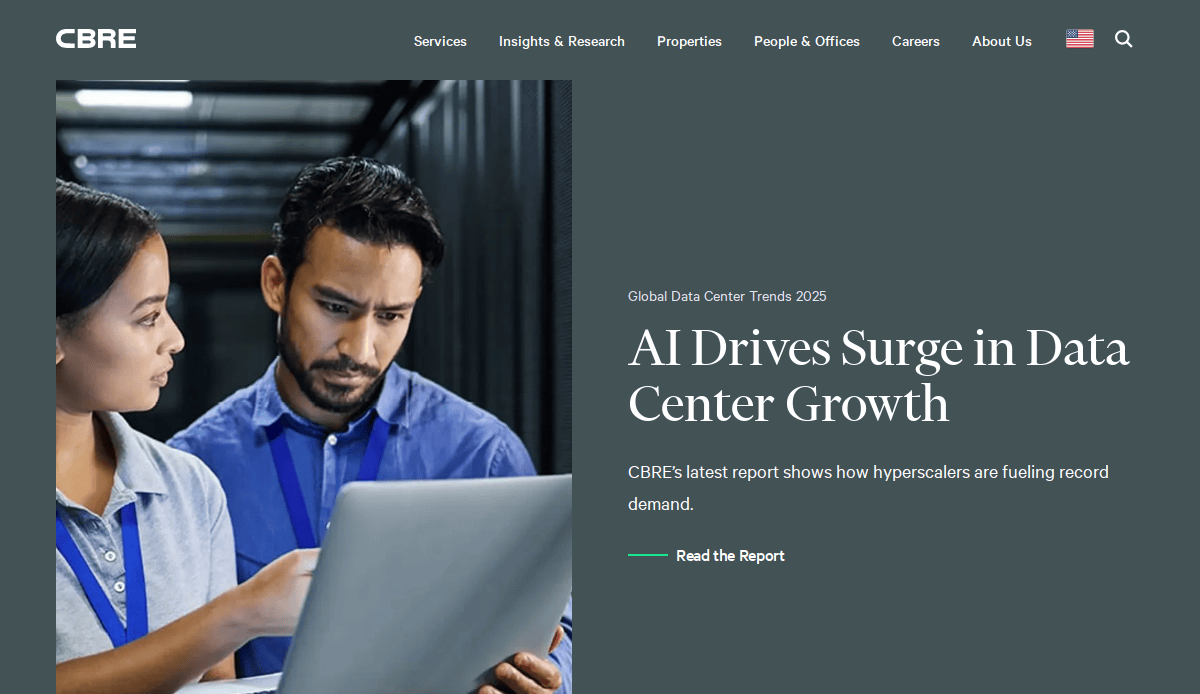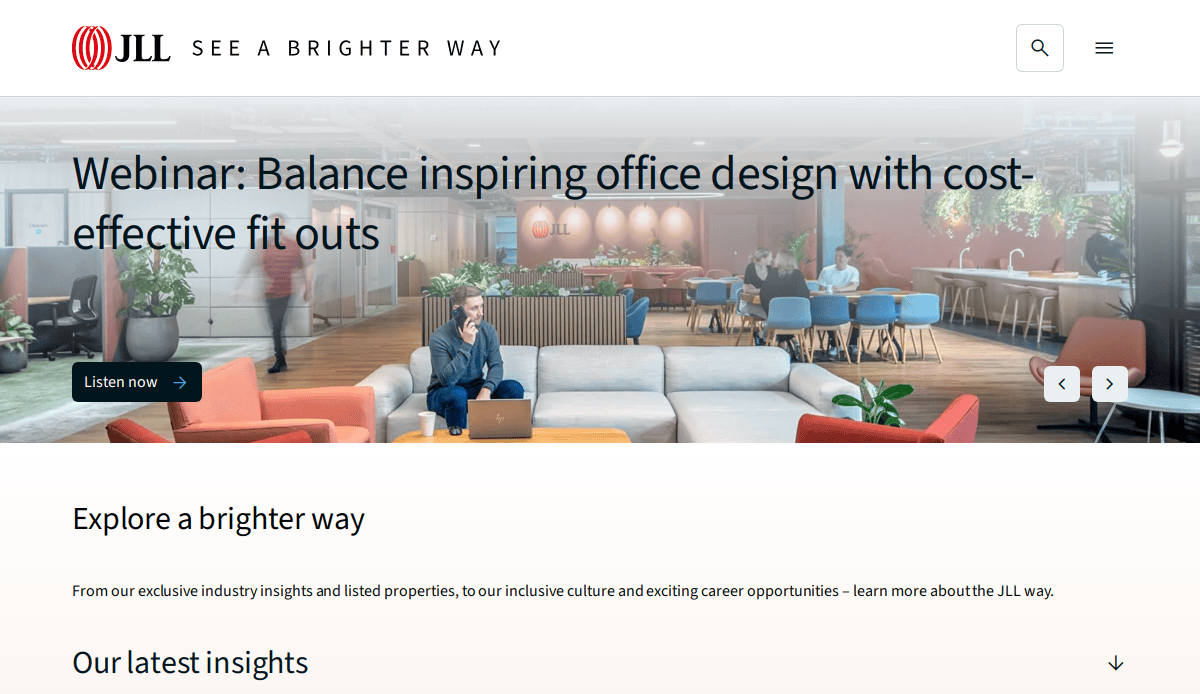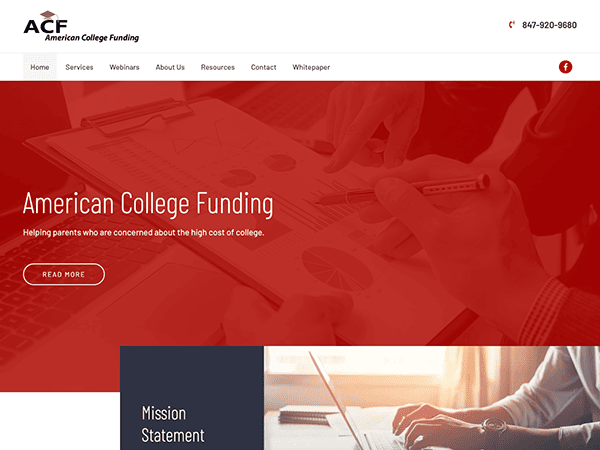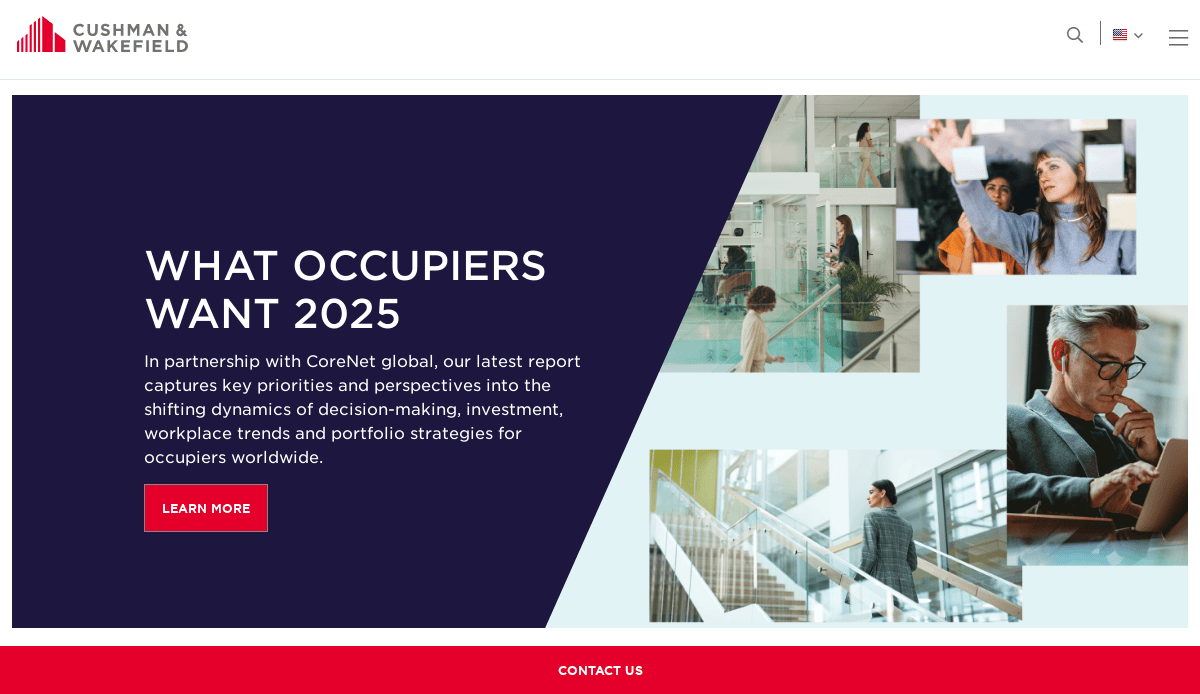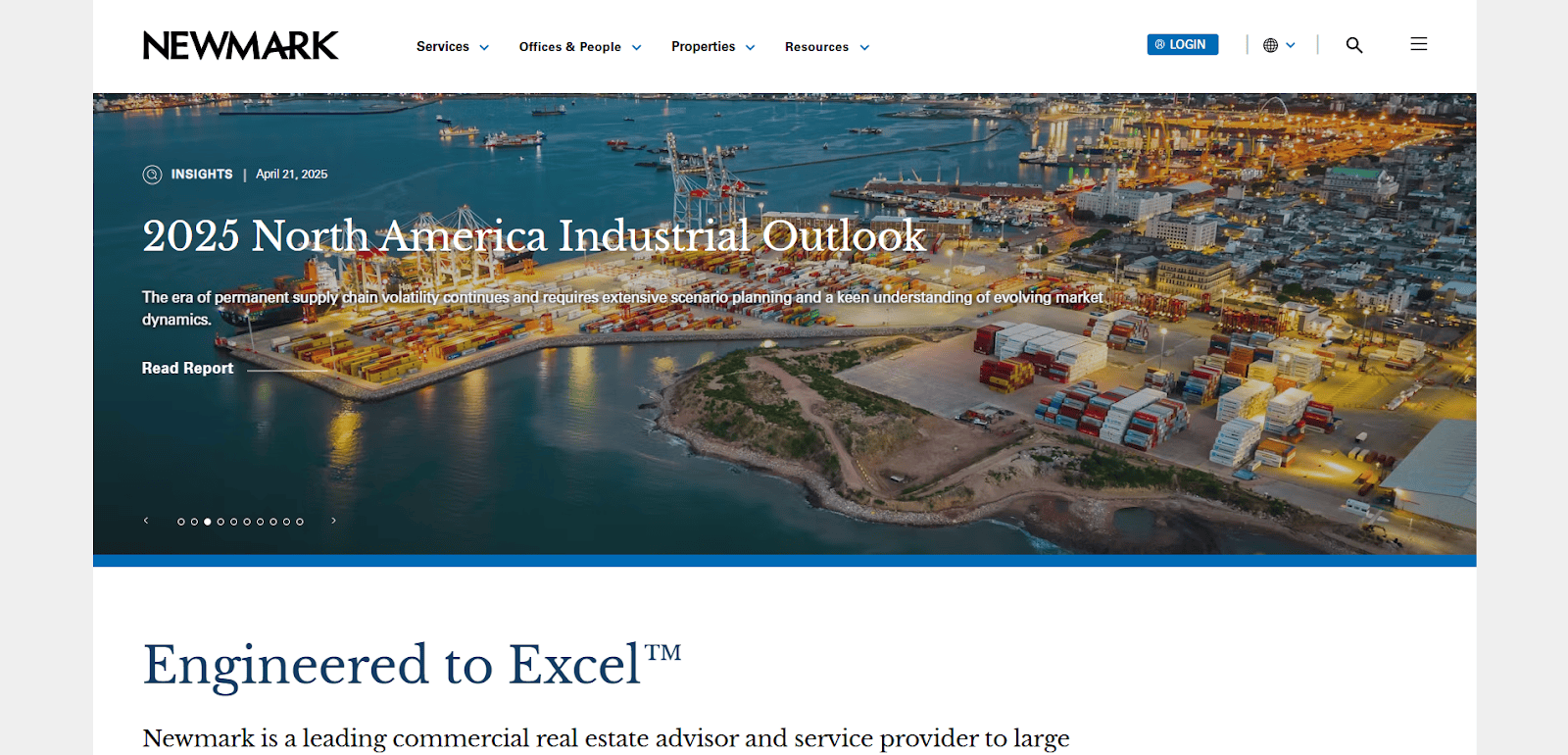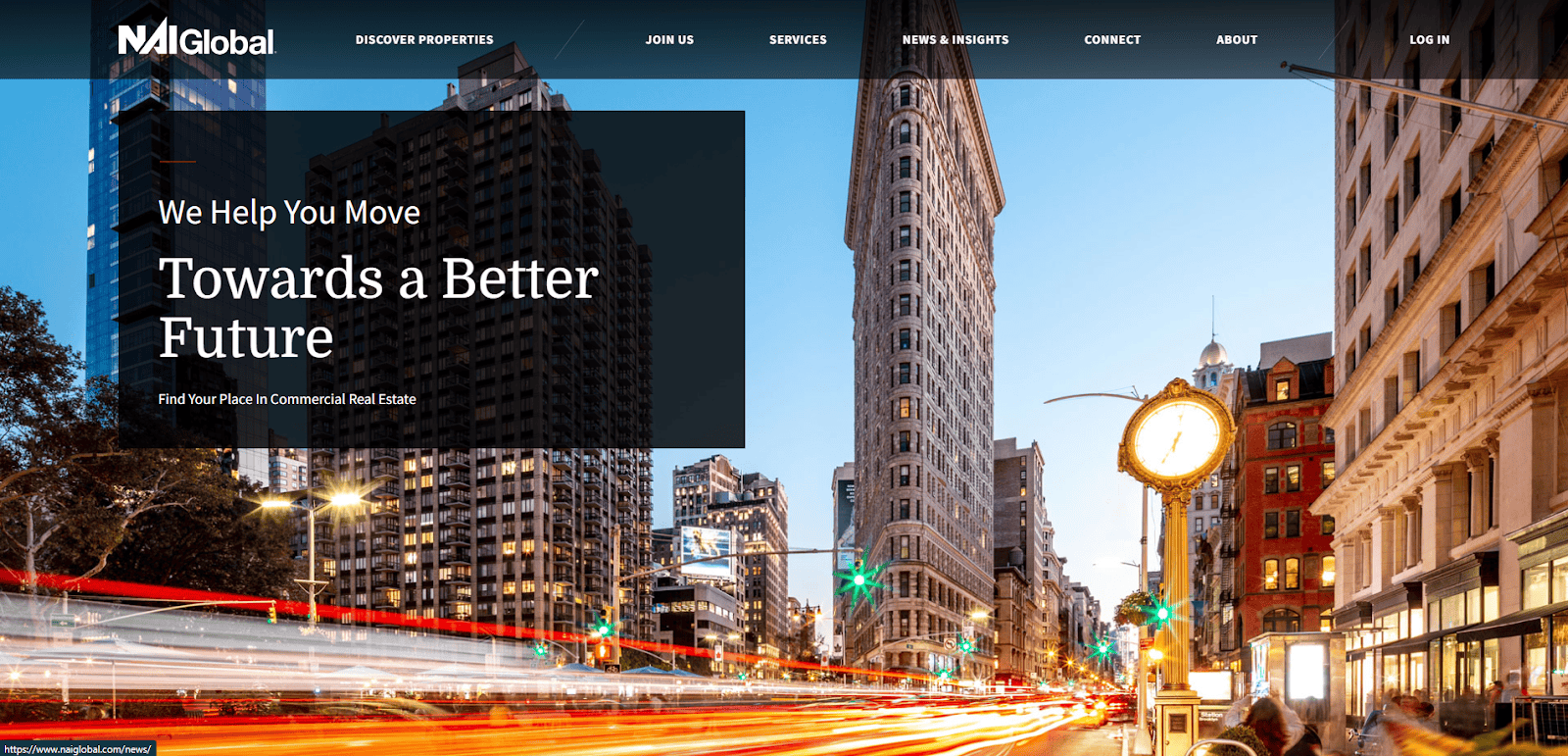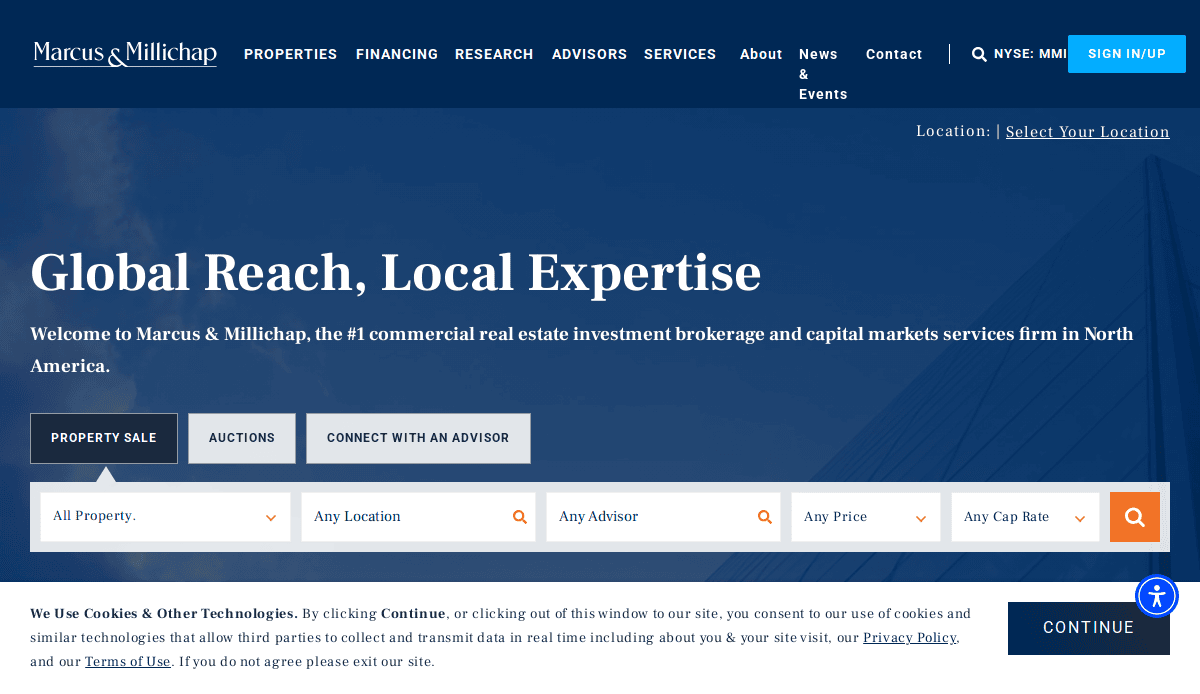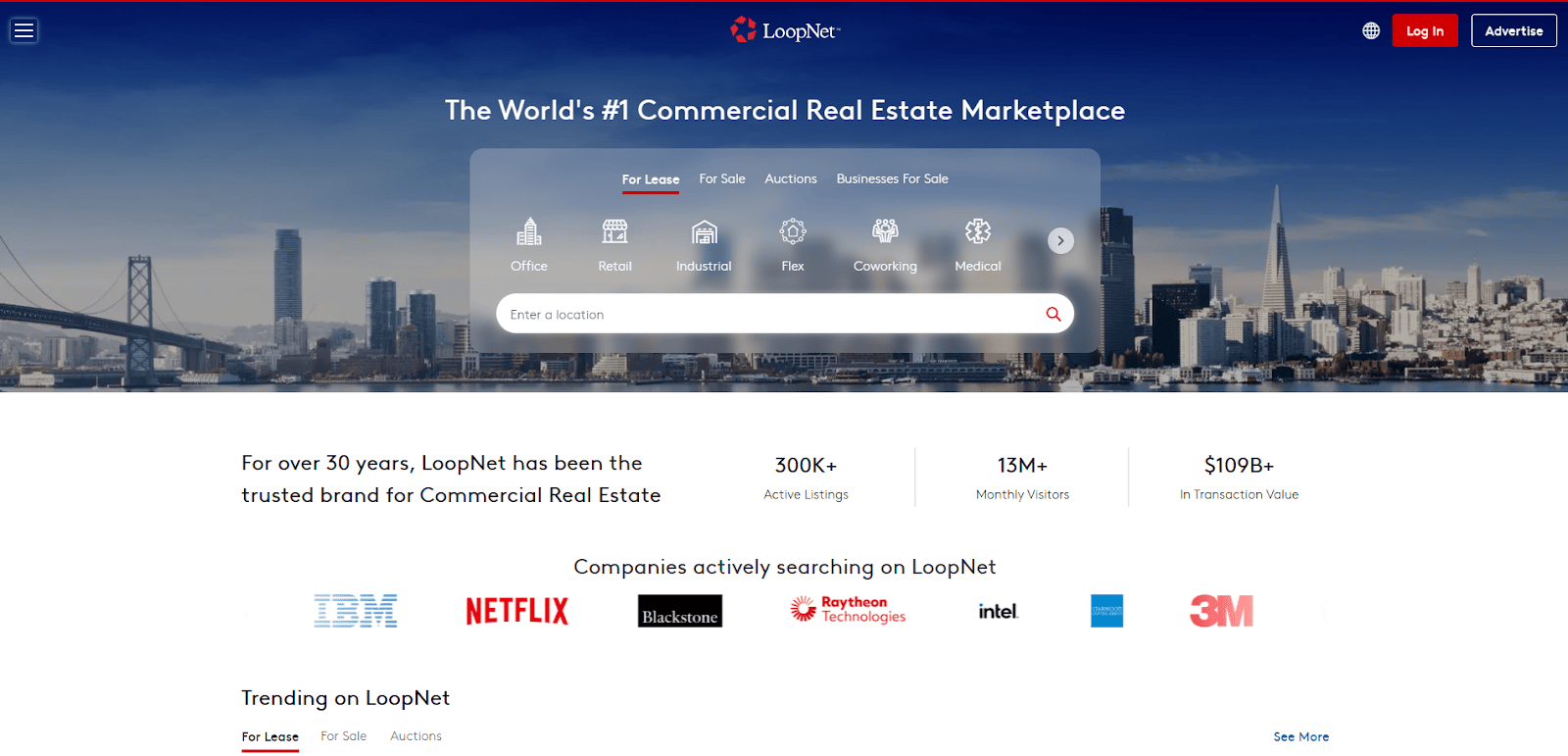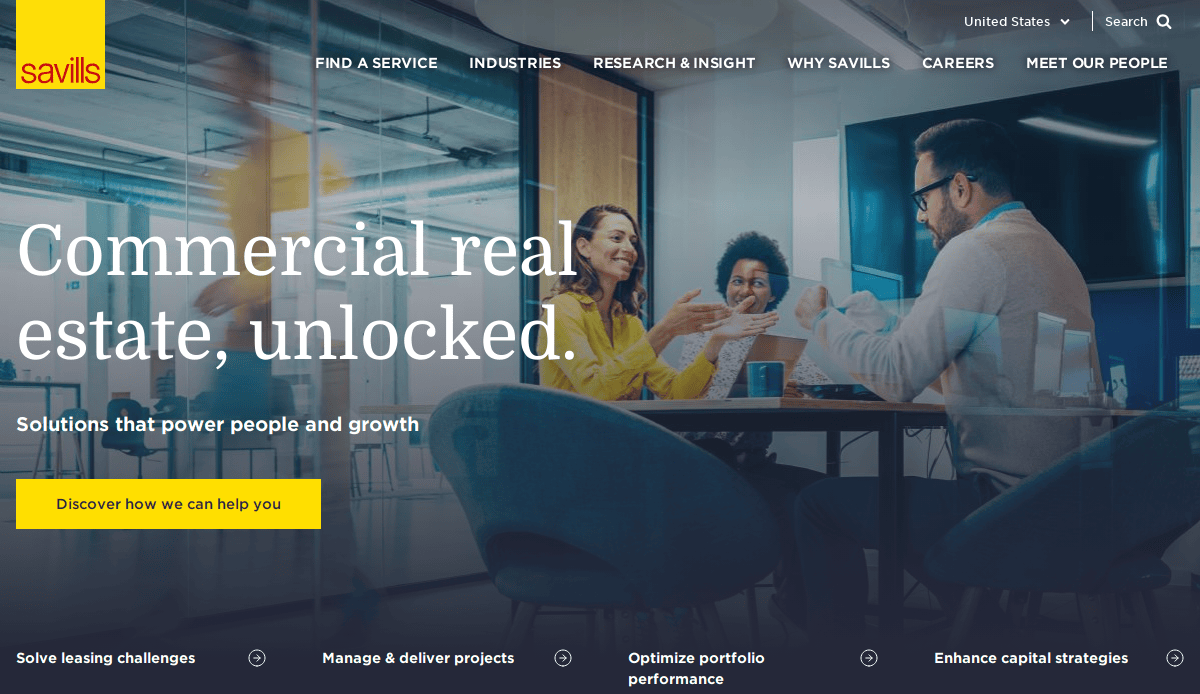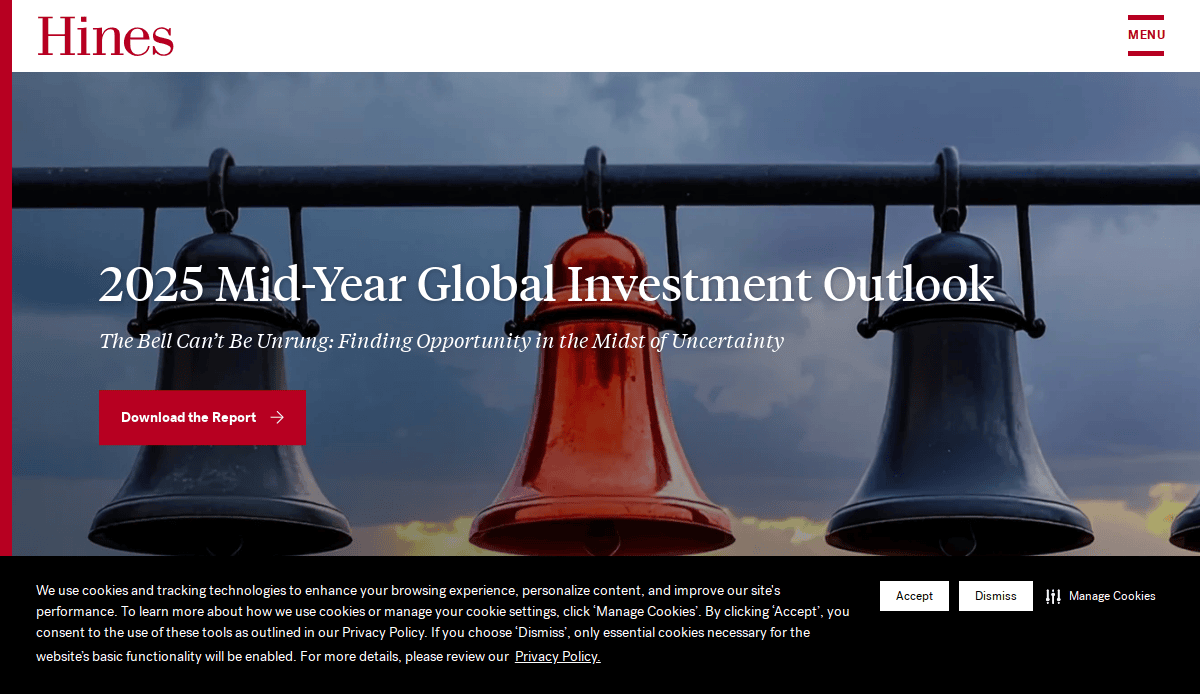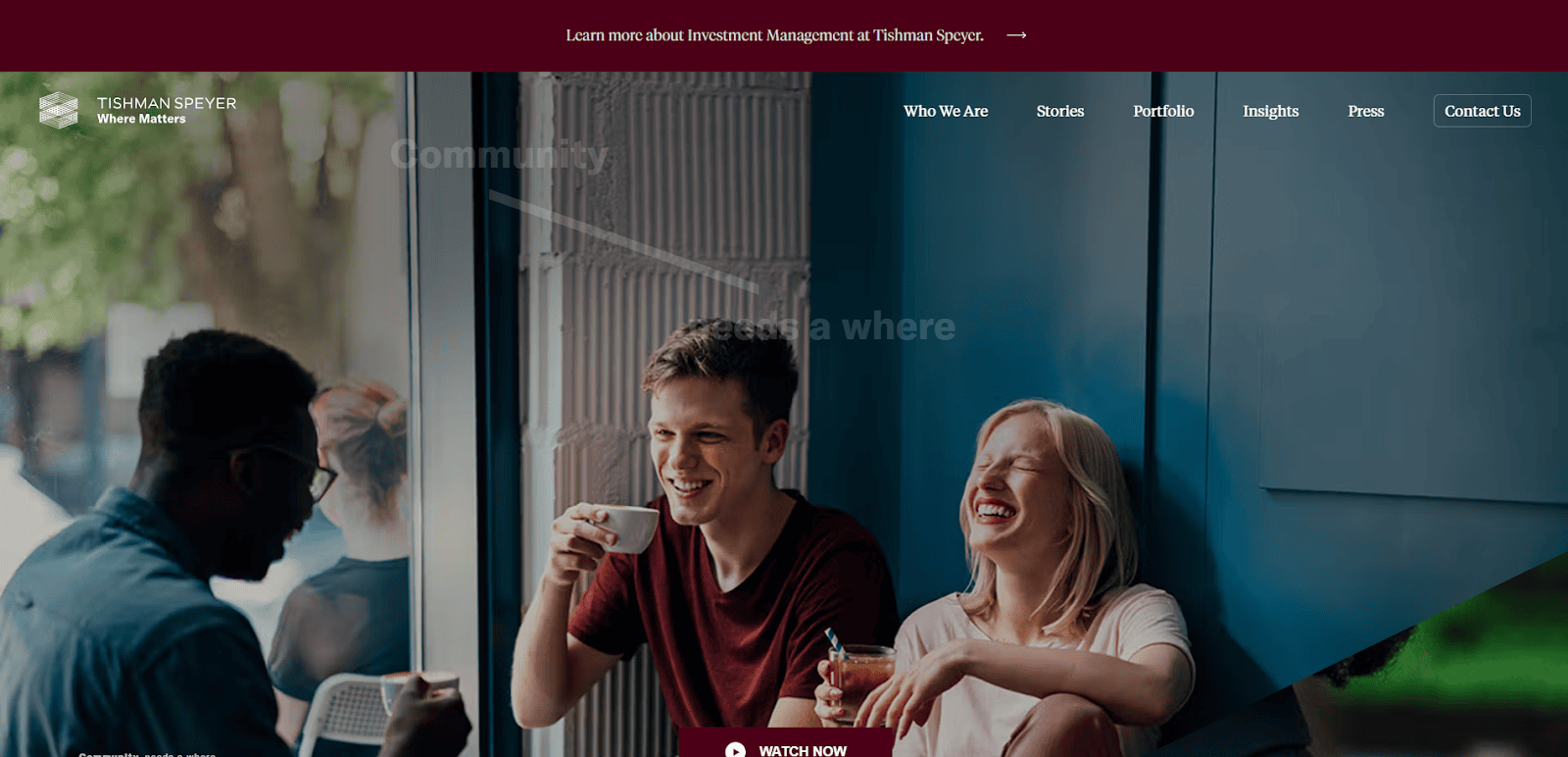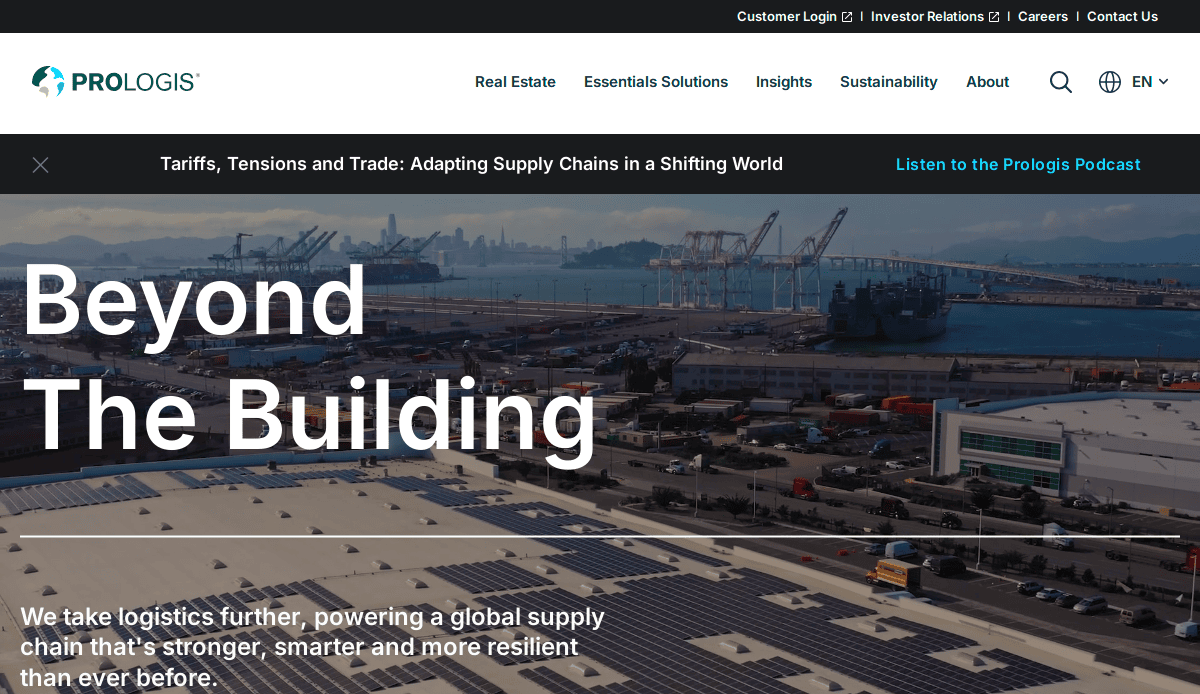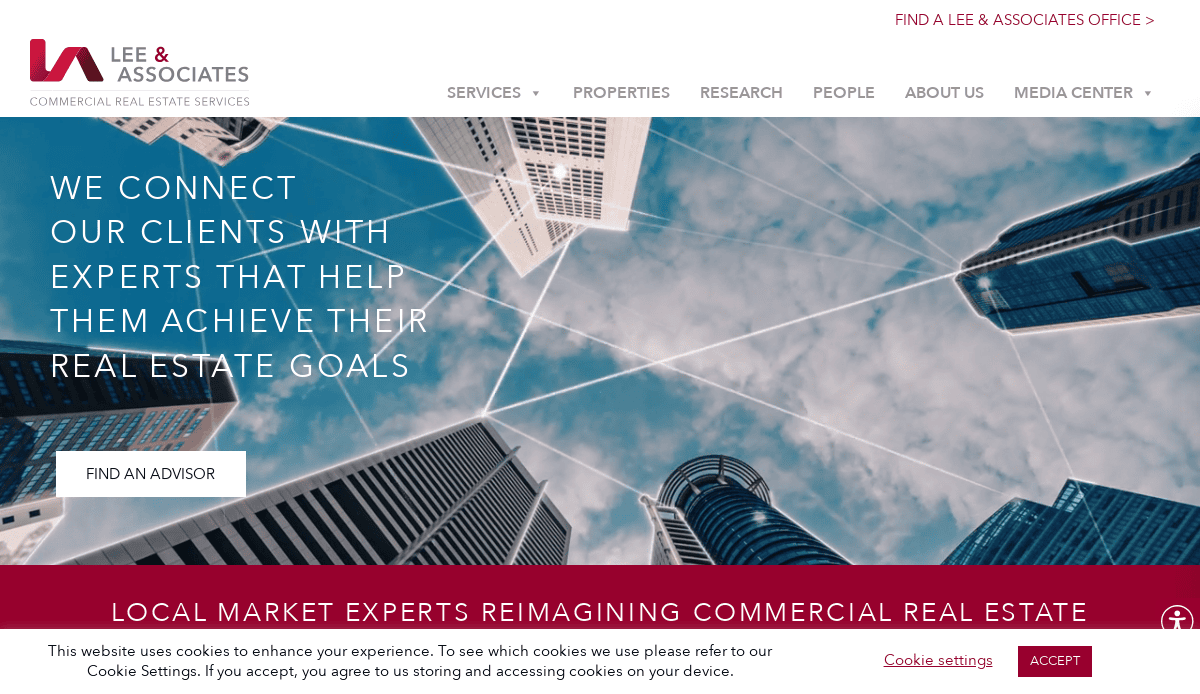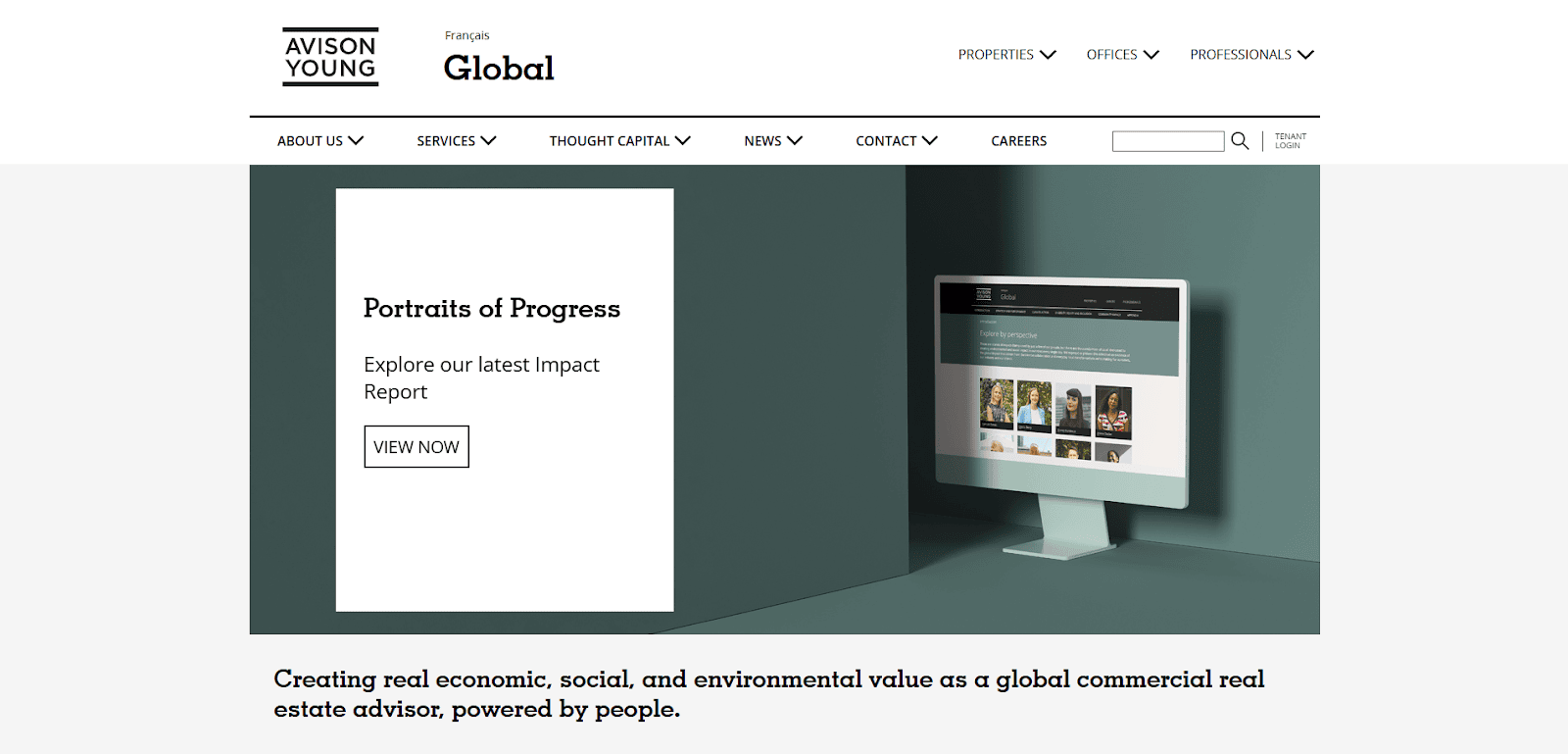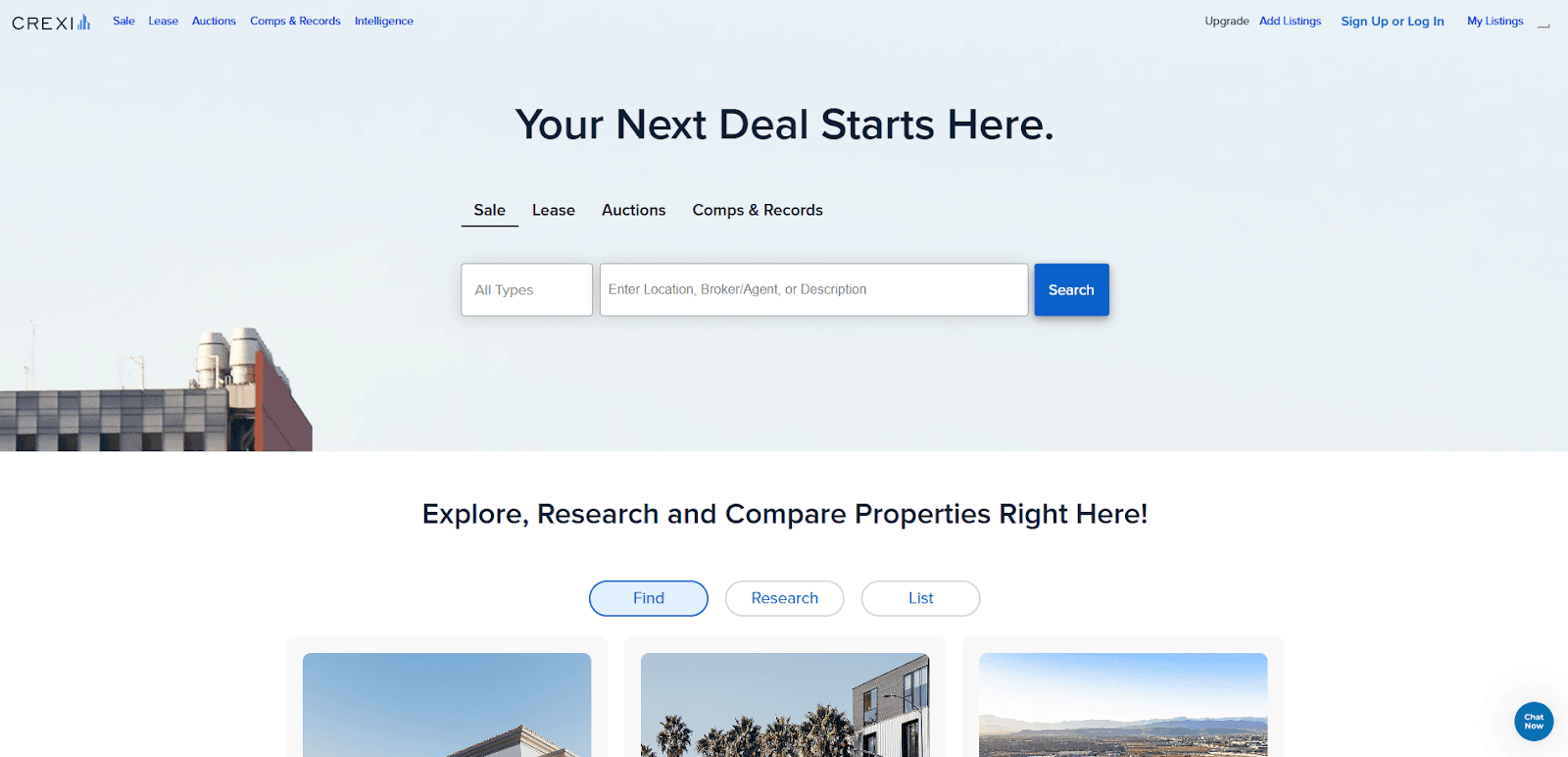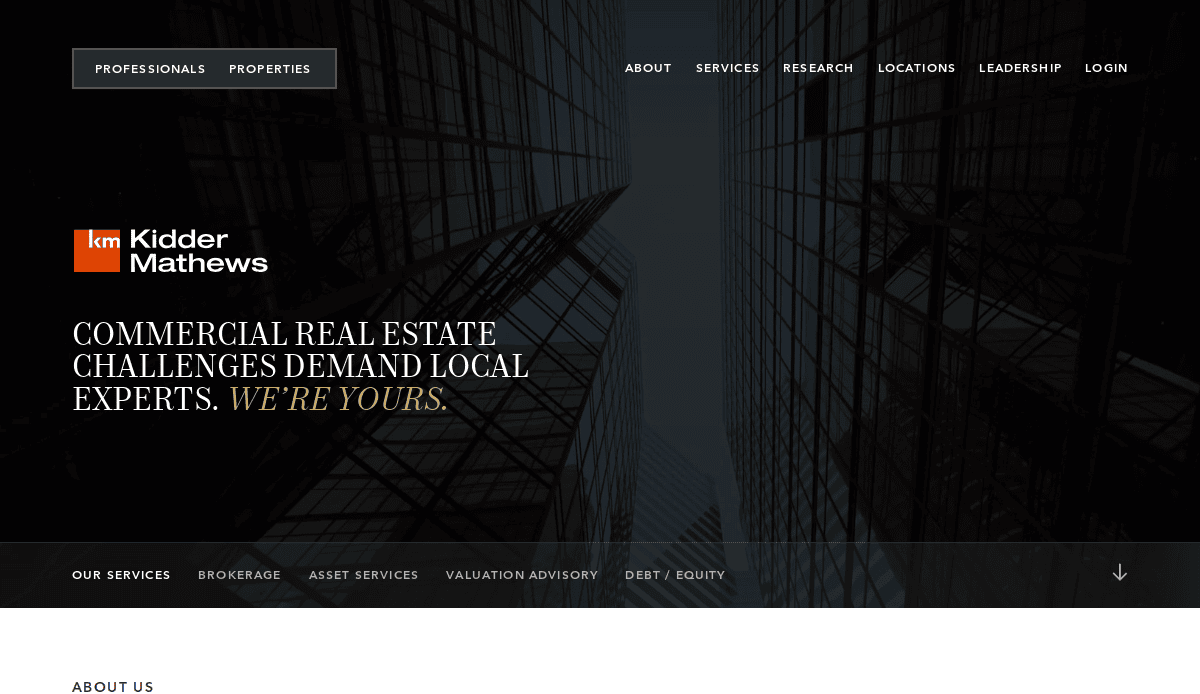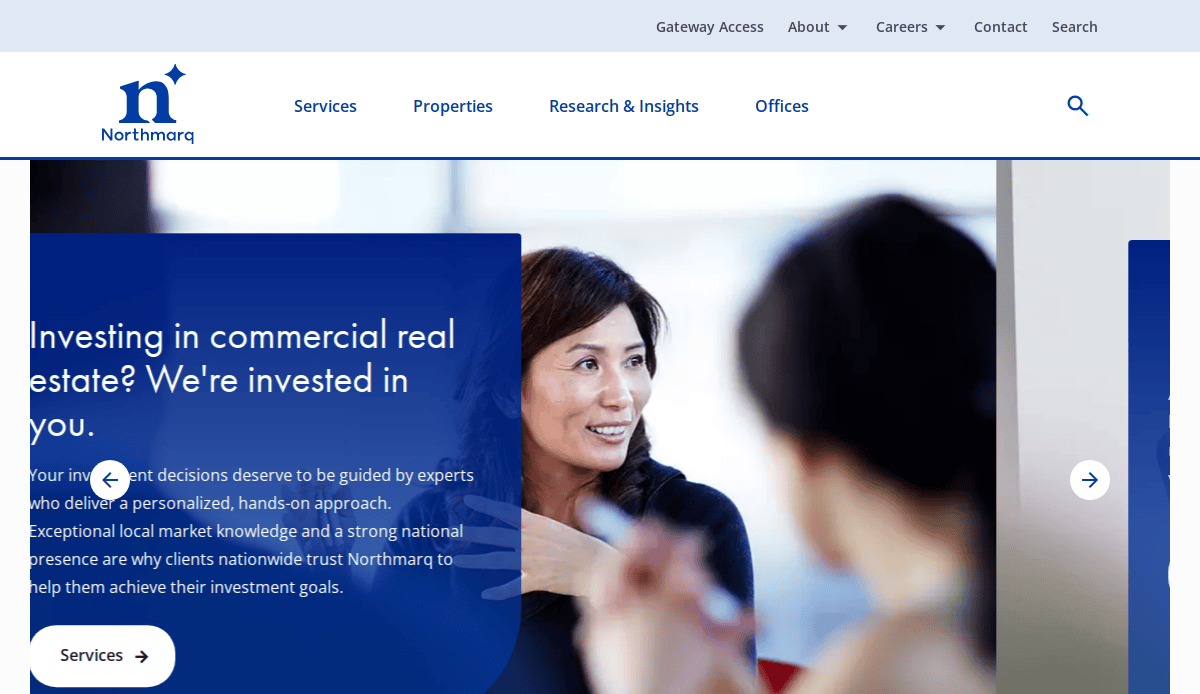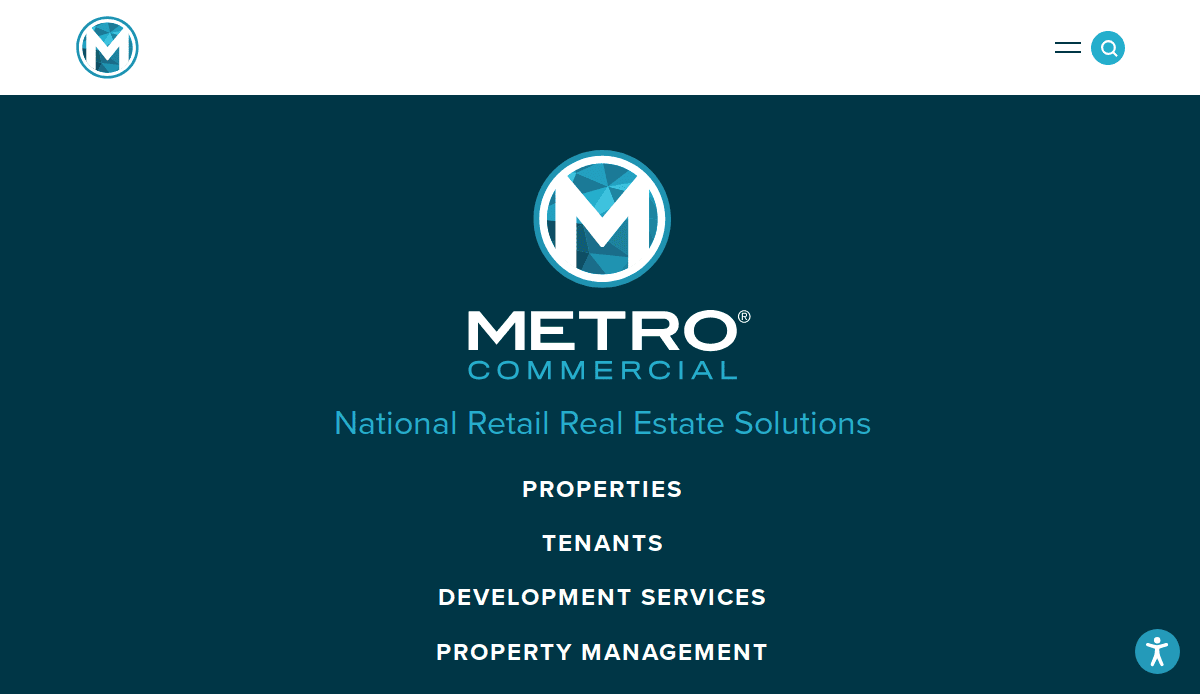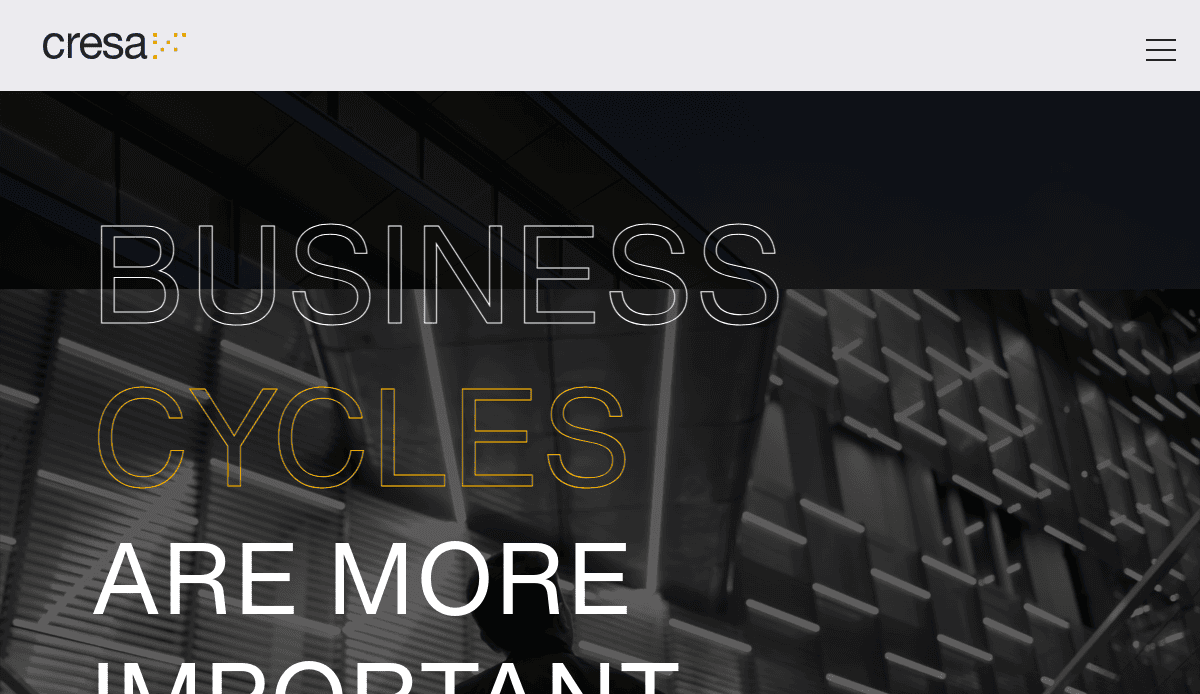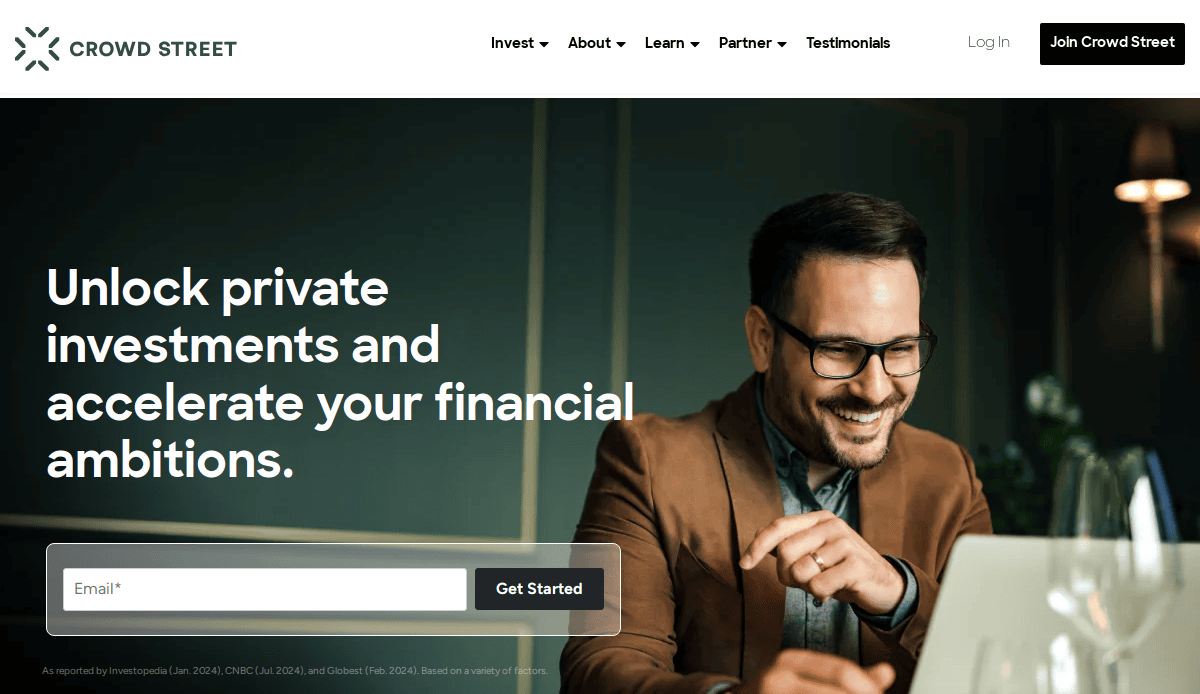Just looking for our Best Commercial Real Estate Website examples list?
Designing a commercial real estate (CRE) website requires a strategic blend of user-centric design, advanced technology, and robust SEO practices. Here are the essential takeaways to ensure it stands out and effectively converts visitors into clients:
- Prioritize Mobile-First and Responsive Design
With a significant increase in property searches conducted on mobile devices, ensuring your website is mobile-friendly is crucial. Responsive design enhances user experience and is favored by search engines, contributing to better SEO rankings. - Integrate Advanced Visual Tools
Incorporate high-quality images, 3D virtual tours, and interactive maps to provide immersive property experiences. These features engage visitors and help in pre-qualifying leads by offering comprehensive property insights. - Implement AI-Powered Search and Personalization
Utilize AI-driven search functionalities to offer personalized property recommendations based on user behavior and preferences. This enhances user engagement and streamlines the property discovery process. - Optimize for Local SEO
Enhance your website’s visibility in local search results by optimizing for location-specific keywords, maintaining an up-to-date Google Business Profile, and acquiring local backlinks. This strategy is vital for attracting clients in specific geographic areas. - Focus on Fast Loading Times
Ensure your site loads quickly by optimizing images, leveraging browser caching, and minimizing code. Fast-loading websites reduce bounce rates and improve user satisfaction, which are critical factors for SEO performance. - Utilize Clear Calls-to-Action (CTAs)
Design prominent and persuasive CTAs to guide visitors toward desired actions, such as scheduling a viewing or contacting an agent. Effective CTAs can significantly increase conversion rates. - Maintain Consistent Branding and Professional Design
Ensure that your website reflects your brand’s identity through consistent use of colors, fonts, and messaging. A professional and cohesive design builds trust and credibility with potential clients. - Provide Comprehensive Property Information
Offer detailed property listings with essential information, including high-resolution photos, floor plans, pricing, and amenities. Comprehensive listings help users make informed decisions and reduce the need for additional inquiries. - Incorporate Client Testimonials and Case Studies
Showcase success stories and testimonials to build trust with prospective clients. Real-life examples of satisfied clients can influence decision-making and demonstrate your expertise in the CRE market. - Regularly Update Content and Listings
Keep your website content fresh by regularly updating property listings, blog posts, and market insights. Consistent updates signal to search engines that your website is active, which can positively impact SEO rankings.
Implementing these strategies will position your custom website as a valuable resource for clients and a powerful tool for business growth.
Why Website Design Matters in Commercial Real Estate
When it comes to sites online, first impressions aren’t made in person—they’re made online. The moment a prospective tenant, investor, or buyer visits your website, they’re already forming opinions about your professionalism, trustworthiness, and the value of your properties. That’s why investing in strategic, high-performing site design isn’t a luxury—it’s a necessity.
A well-executed website design does more than just display properties. It guides users through a seamless journey, tells your brand’s story, and compels them to take action. Whether you’re a developer, a real estate agent, or a brokerage firm, the right website can directly influence your lead generation, deal velocity, and long-term credibility in the market.
Unfortunately, too many businesses settle for generic templates or drag-and-drop website builder platforms that fall short of expectations. If you want to stand out and make your website work as hard as you do, responsive design, custom features like interactive maps, and property filtering tools are no longer optional—they’re expected.
This guide will show you how to create a real estate website that looks great and performs well. From foundational design principles to the latest digital trends, we’ll cover everything you need to transform your site into a powerful marketing and sales engine for your real estate business.
Website Planning & Purpose in CRE
Before a single pixel is designed or a property photo is uploaded, successful websites begin with one thing: a clear plan. This foundational step shapes every decision moving forward, from layout and user experience to SEO strategy and lead generation tools.
In this industry, your website is a central hub for showcasing available properties, establishing credibility, and converting visitors into clients. Because of this, planning should start by defining your core goals. Are you trying to lease office space, attract investors, or build long-term brand recognition in a competitive market? Each objective requires a different approach to site design and content strategy.
Audience definition is equally critical. Knowing whether you’re speaking to investors, tenants, brokers, or corporate clients will help determine what features and messaging will resonate most. A leasing-focused site might emphasize square footage, location benefits, and floor plans, while an investor-facing platform should highlight portfolio performance, property returns, and development expertise.
Functionality also needs to be mapped out early. Features like advanced property search, integration with CRM tools, virtual tours, and real-time availability are no longer optional. These tools are essential for meeting modern expectations and ensuring your website delivers value to both users and your business.
To help guide this critical phase, consider following a structured planning framework. Our agency’s step-by-step guide to the web design process outlines how to align your website’s goals with user needs, ensuring a streamlined project from discovery to launch.
When you treat planning as a strategic exercise—not an afterthought—you lay the foundation for a website that drives results, supports business development, and adapts as your portfolio grows.
Design Principles That Drive Results
Great site design is more than just aesthetics—it’s about function, clarity, and persuasion. In a space where every second counts and competition is fierce, the right design principles can be the difference between a visitor bouncing or converting.
Clarity and simplicity are non-negotiable. The layout should be clean, intuitive, and purpose-driven. Visitors should instantly understand what your company does, what properties are available, and how to take the next step. Avoid cluttered pages or excessive animations that distract from the message or slow down load times.
Hierarchy matters. Use visual cues like bold headings, whitespace, and strategic color placement to guide users through your content. For example, property highlights should be front and center, with clear calls-to-action prompting users to schedule a tour, download a brochure, or get in touch. Every design element should move users closer to a business objective.
Responsive design is a must. More than half of all web traffic now comes from mobile devices, and in commercial real estate, many prospects are viewing listings while on the go. If your site isn’t optimized for mobile viewing—with fast loading times and touch-friendly navigation—you’re losing leads.
Brand consistency is just as important as functionality. Fonts, colors, and imagery should align with your company’s identity and communicate trust and professionalism. An inconsistent look can confuse users or make your brand appear less credible. A refined and modern visual identity reflects the value of the properties you represent.
Trust indicators should be built into the design. This includes testimonials, market stats, client logos, and industry certifications. These elements reinforce your authority and provide social proof that encourages new clients to engage.
When these principles are executed well, the result is a site that doesn’t just look good—it performs. For examples and deeper insights into real estate-specific design strategies, explore our expert’s work in the real estate website design industry. You’ll see how thoughtful design translates directly into measurable business results.
Structuring Content and Navigation
A high-performing website depends just as much on its content structure and navigation as it does on design. The way information is organized—and how easily users can find it—plays a major role in whether visitors stay engaged or leave your site altogether.
The first rule of content structure is prioritizing clarity. Visitors should immediately understand who you are, what you offer, and how they can work with you. That means clear section headings, concise property descriptions, and a consistent voice across all pages. Avoid industry jargon unless it’s used in a way that adds clarity or reinforces credibility with a specific audience.
Navigation should be streamlined and intuitive. Every page must be reachable within two to three clicks, and the top navigation bar should include the most critical sections: Properties, About Us, Services, Resources or Blog, and Contact. Drop-down menus can help organize subcategories like property types, regions, or asset classes without overwhelming users.
For content-heavy pages such as property listings or blog articles, use filtering and search tools. These features help users quickly locate information relevant to their needs, such as available office space in a specific neighborhood or recent market trends. This level of convenience adds value and keeps visitors engaged longer.
Additionally, your homepage should act as a gateway to deeper content. It should introduce your firm, feature spotlight listings, and highlight core services or market sectors you serve. Include strategic internal links to guide users through your site based on their intent, whether they’re browsing listings or learning more about your team’s experience.
The structure must also support SEO. Each page should be optimized around specific keywords and feature meaningful metadata, H-tags, and internal linking. This ensures your site is discoverable by search engines and aligns with user queries.
If you’re unsure where to start, take cues from successful peers. We break this down in their guide on how real estate companies can make the most of their website, offering valuable insight into turning a website into a business-generating asset.
In short, content and navigation aren’t just about aesthetics or usability—they directly influence how effective your site is at converting visitors into qualified leads. Make sure every page and link supports that end goal.
Ongoing WordPress Maintenance
Launching a website on WordPress is only the beginning. To keep your site secure, fast, and effective over time, ongoing maintenance is essential. Without regular updates and performance monitoring, even the best-designed site can become a liability rather than an asset.
For commercial real estate firms, website uptime and data integrity are critical. Potential clients rely on your site for real-time property information and contact details. If a plugin breaks, a page won’t load, or the site goes down, it can directly impact lead generation and your reputation. Routine maintenance ensures that core functions like property searches, contact forms, and image galleries stay fully operational.
Security is one of the most pressing concerns. WordPress powers a significant portion of the web, making it a frequent target for bots and hackers. Maintenance involves keeping WordPress core, themes, and plugins updated to patch vulnerabilities as soon as updates are released. Installing a firewall, enabling two-factor authentication, and running malware scans should be part of your monthly routine.
Speed and performance optimizations also fall under ongoing care. Large image files from property listings can drag down load times. Maintenance should include compressing media, cleaning up unused plugins or themes, and reviewing performance reports to ensure your site stays fast, especially on mobile devices, where load time directly affects user engagement.
Backups are your insurance policy. Automated daily or weekly backups ensure that if anything goes wrong—whether it’s a corrupted update or accidental deletion—you can restore the site quickly without starting from scratch. Backups should include both your files and database to fully protect your property data and design.
Beyond the technical aspects, content and SEO updates also matter. As your commercial real estate portfolio evolves, listings change, and blog content becomes outdated. Regularly updating your content and optimizing new pages helps your website remain relevant in search results and aligned with your marketing goals.
Ongoing WordPress maintenance isn’t just a backend task—it’s a strategic investment in keeping your commercial real estate website stable, secure, and results-driven. It ensures that your site continues to reflect your brand’s reliability and professionalism long after launch.
Best CRE Website Examples
1. CBRE
Location: Dallas, TX
Key Takeaways:
- Global Reach: Offers comprehensive property listings worldwide.
- User-Friendly Interface: Intuitive navigation enhances user experience.
- Market Insights: Provides in-depth research and reports.
2. JLL
Location: Chicago, IL
Key Takeaways:
- Modern Design: Sleek visuals with interactive elements.
- Comprehensive Services: Covers various real estate sectors.
- Thought Leadership: Regularly updated blogs and insights.
3. Colliers
Location: Seattle, WA
Key Takeaways:
- Dynamic Content: Features client success stories.
- Advanced Search: Easy property filtering options.
- Global Presence: Extensive international listings.
4. Cushman & Wakefield
Location: Chicago, IL
Key Takeaways:
- Sophisticated Aesthetics: Bold headlines with a refined color palette.
- Organized Layout: Clear sections for services and insights.
- Engaging CTAs: Encourages user interaction.
5. Newmark
Location: New York, NY
Key Takeaways:
- High-Resolution Imagery: Showcases properties effectively.
- Minimalist Design: Focuses on essential information.
- Easy Navigation: Streamlined user journey.
6. NAI Global
Location: Princeton, NJ
Key Takeaways:
- Global Network: Highlights international reach.
- Clean Design: Emphasizes clarity and efficiency.
- Detailed Listings: Comprehensive property information.
7. Marcus & Millichap
Location: Calabasas, CA
Key Takeaways:
- Investor Focused: Tailored content for investors.
- Dynamic Search: Filters properties by various criteria.
- Research Tools: Access to market analyses.
8. LoopNet
Location: Washington, DC
Key Takeaways:
- Extensive Listings: Vast database of commercial properties.
- Streamlined Design: User-friendly interface.
- Advanced Filters: Helps users find specific properties.
9. Savills
Location: New York, NY
Key Takeaways:
- International Flair: Combines global and local expertise.
- Interactive Features: Clickable maps and advanced search.
- Sustainability Focus: Emphasizes eco-friendly practices.
10. Hines
Location: Houston, TX
Key Takeaways:
- Cinematic Visuals: Engaging video backgrounds.
- Straightforward Navigation: Easy access to portfolios.
- Cultural Values: Highlights company ethos.
11. Tishman Speyer
Location: New York, NY
Key Takeaways:
- Minimalist Approach: Clean design with high-quality imagery.
- Global Presence: Showcases international projects.
- Insightful Content: Articles and case studies available.
12. Prologis
Location: San Francisco, CA
Key Takeaways:
- Industrial Focus: Specializes in logistics facilities.
- Global Operations: Extensive international footprint.
- Investor Information: Detailed financial data available.
13. Lee & Associates
Location: Phoenix, AZ
Key Takeaways:
- Professional Design: Sleek and modern aesthetics.
- Comprehensive Listings: Detailed property information.
- User-Friendly Interface: Easy navigation and search.
14. Avison Young
Location: Chicago, IL
Key Takeaways:
- Elegant Design: Classy black-and-white color palette.
- Informative Content: Comprehensive property details.
- Global Reach: International property listings.
15. Crexi
Location: Los Angeles, CA
Key Takeaways:
- User-Friendly Interface: Clean and functional design that enhances user experience.
- Comprehensive Listings: Extensive database of commercial properties across various sectors.
- Advanced Search Filters: Allows users to efficiently narrow down property searches.
16. Kidder Mathews
Location: Seattle, WA
Key Takeaways:
- Straightforward Design: Prioritizes clarity and information.
- Comprehensive Services: Covers various real estate sectors.
- Regional Expertise: Focus on the West Coast market.
17. Northmarq
Location: Minneapolis, MN
Key Takeaways:
- Organized Layout: Balances text and imagery effectively.
- Fast Loading Speeds: Enhances user experience.
- Detailed Listings: In-depth property information.
18. Metro Commercial
Location: Mount Laurel, NJ
Key Takeaways:
- Urban Feel: Cool tones and city-centric design.
- Impressive Navigation: User-friendly interface.
- Retail Focus: Specializes in retail property listings.
19. Cresa
Location: Washington, DC
Key Takeaways:
- Bold Layout: Unorthodox design elements.
- Exceptional Visuals: High-quality imagery throughout.
- Tenant Representation: Focused on occupier services.
20. CrowdStreet
Location: Portland, OR
Key Takeaways:
- Investment Platform: Connects investors with CRE opportunities.
- Detailed Project Information: Comprehensive deal data.
- Educational Resources: Webinars and articles for investors.
Ready to Build a Real Estate Website That Performs?
In the competitive world of commercial real estate, your website is your most powerful sales tool. Whether you’re attracting tenants, engaging investors, or showcasing premium commercial properties, a well-designed website delivers the credibility, visibility, and performance your business demands. From layout to SEO to functionality, every element should align with your goals in the real estate market.
This guide has equipped you with foundational design principles, strategic planning insights, and key features for your real estate site. Now, it’s time to put that knowledge into action. Don’t let a dated or ineffective site hold your business back from making the impact it should.
If you’re ready to make your real estate website work harder for you, partner with a real estate website developer who understands your industry, audience, and ambitions.
Request a free consultation with our top-tier web design and development agency, and start building a professional real estate website that drives results.
Professional CRE Web Design FAQs
What essential features does a CRE website need?
A successful CRE website must include high-resolution imagery, advanced property search filters, interactive maps, and mobile-responsive design. These essential features ensure a professional website that attracts and converts commercial real estate clients. Adding client testimonials, fast load speeds, and SEO-friendly structures further supports credibility and visibility in a competitive real estate market.
How is building a real estate website different from other industries?
Website development for the real estate industry requires a deeper focus on showcasing real estate listings, integrating property data feeds, and facilitating user engagement through tools like saved searches and virtual tours. Unlike other sectors, real estate websites must cater to a range of users, including investors, estate brokers, tenants, and business buyers, each requiring access to tailored information and features.
Do I need a custom website, or can I use a website builder?
While website builders like Wix or Squarespace can serve basic needs, a custom real estate website built by an experienced web developer ensures your platform is optimized for performance, SEO, and your unique goals. Custom development supports integration with CRM systems, IDX feeds, and specific branding standards, crucial in the professional real estate world.
How does real estate SEO help my website?
Real estate SEO improves your site’s visibility in search engines, helping you attract local real estate traffic and connect with users actively seeking properties or investment opportunities. By targeting specific real estate topics, including location-based keywords and content about different types of real estate, you drive qualified website visitors and generate higher-quality leads.
What type of website design is best for commercial listings?
The best designs should support advanced filtering for square footage, location, property type, and lease/sale terms. It must also integrate well with commercial real estate platforms, support downloadable brochures or floor plans, and provide space for highlighting ROI metrics for real estate investors. A clean, modern real estate website feel is crucial to meet the expectations of business-oriented buyers.
How important is mobile responsiveness in commercial real estate site design?
Mobile responsiveness is non-negotiable. More than half of real estate website visitors access content via mobile devices. If your website isn’t optimized for mobile, you risk losing valuable leads. A responsive design ensures your real estate agency appears professional across all screen sizes and maintains user engagement from first visit to inquiry.
What role does branding play in real estate website development?
Branding shapes how your real estate agency is perceived online. A consistent brand experience across your custom real estate site helps build trust and differentiate your firm in the growing real estate sector. From logo placement to color palettes and font choices, your branding must reflect the professionalism and niche expertise of your team of real estate professionals.
Should I include a blog on my real estate website?
Yes. A blog supports SEO, establishes thought leadership, and provides ongoing value to both clients and search engines. Covering real estate topics such as market trends, investment strategies, and local neighborhood insights enhances user experience and builds topical authority.
How often should I update my commercial real estate site?
Updates should occur regularly to reflect new listings, team changes, and SEO improvements. A modern real estate website requires ongoing content optimization, technical maintenance, and design refinements to remain effective. Frequent updates signal to Google that your site is active and relevant, key for maintaining visibility in a competitive real estate space.
Can a real estate website help attract investors?
Absolutely. For those in the real estate investment space, a professional real estate website can serve as a portfolio, communication tool, and lead generator. Including detailed property performance data, case studies, and market insights builds trust and positions your real estate agency as a knowledgeable and experienced player in the investment sector.

